Galleries
At Hauser & Wirth, Subodh Gupta Shows He is More and Less Than the ‘Damien Hirst of Delhi’
The Indian artist's big show illustrates the perils of the new era of accelerated global art celebrity.
The Indian artist's big show illustrates the perils of the new era of accelerated global art celebrity.
Ben Davis

Food is Subodh Gupta’s big theme. His most well-known gimmick is to build up sculptures out of pots and pans, utensils that he sees as emblematic of salt-of-the-earth Indian culture. Yet when I look at “Seven Billion Light Years,” his just-opened show at Hauser & Wirth, I mainly see appetites of another kind.
Today, Gupta (b. 1964) is India’s most feted artist. He came to prominence during the 2000s, the era of unstoppable “emerging markets,” through the new circuit of art fairs that studded the earth to cater to the hyper-mobile winners of rapacious globalization. His works say as much about the mores of this culture as they do about India itself—that is, they knowingly play off of the art industry’s unique brand of food-court cosmopolitanism, where global culture is always welcome as long as it is served with a soupçon of Marcel Duchamp.
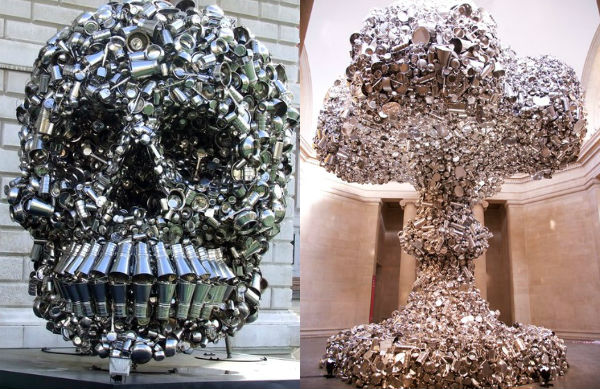
Left: Subodh Gupta’s Very Hungry God (2006) outside the Palazzo Grassi in Venice; right: Line of Control (2008) at the Tate Triennial
Gupta’s most celebrated concoctions include Very Hungry God (2006), a huge skull that mega-collector François Pinault launched into the imagination by plonking it in front of his personal museum in Venice, and Line of Control (2008), a towering mushroom cloud that made Gupta a breakout star of the Tate Triennial in 2009. For me, anyway, these works are contemporary art at its most meh, good for a portentous sound bite and a photo op, but not much more.
“Seven Billion Light Years” contains at least one work to satisfy fans of Gupta’s pan-based work: This is not a fountain (2011-2013), a 25-foot-long, nine-foot-wide heap of his signature cooking dishes. Dozens of spigots poke up through the mass of pots, all of them turned on and flowing water out over the pans, the water vanishing away, presumably into a drain in the floor, gurgling pleasantly.
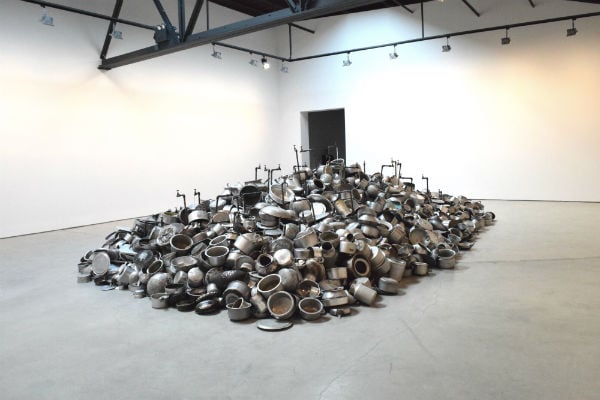
Subodh Gupta’s This is not a fountain (2011-2013) at Hauser & Wirth
Photo: Ben Davis
Up close, This is not a fountain’s pots are dinged up, as if from heavy use. The work evokes Indian domestic life; it uses the contemporary-art tactic of accumulation; it invokes, via its title, Marcel Duchamp’s Fountain and René Magritte’s “Ceci n’est pas une pipe.” It is also big, commanding the space. But these are all like ingredients for a recipe that have been thrown together without measure. As far as I can tell, this sculptural pile of dishes doesn’t add up to anything specific that you wouldn’t know just from seeing these types of utensils on the street in the first place. (When Line of Control showed in Delhi recently, locals are said to have mistaken the spectacular pan-cloud for an ad for a local hypermarket chain.)
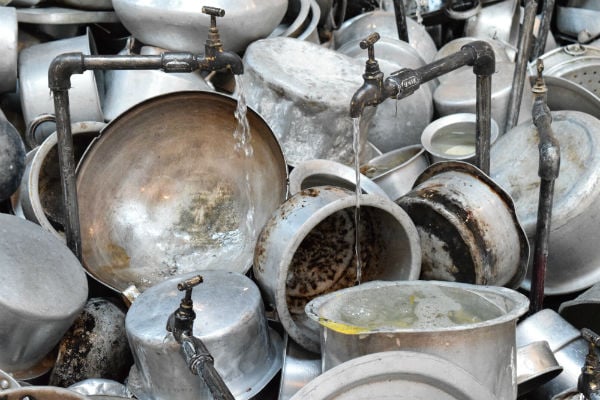
Detail of Subodh Gupta’s This is not a fountain (2011-2013)
Photo: Ben Davis
Elsewhere, a work like Pure (I) (1999/2014) recreates a performance-environment from the very beginning of Gupta’s career, a field of caked, compacted dirt that you walk up onto, donning little hospital-style booties. It is pitted as if from some kind of archeological excavation. When you look down into the holes, nested into them are a variety of everyday objects: some worn shoes; a hookah; a pair of glasses.
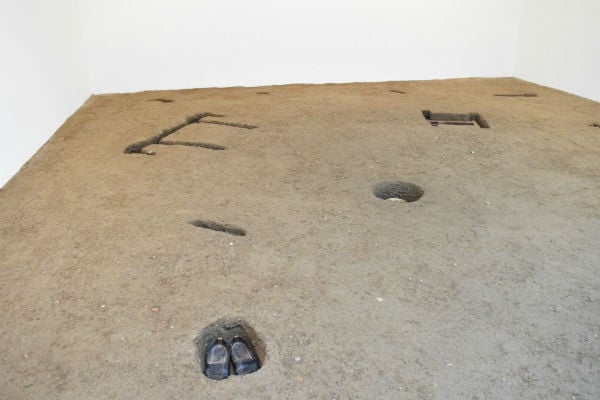
Subodh Gupta’s Pure (I) (1999/2014) at Hauser & Wirth
Photo: Ben Davis
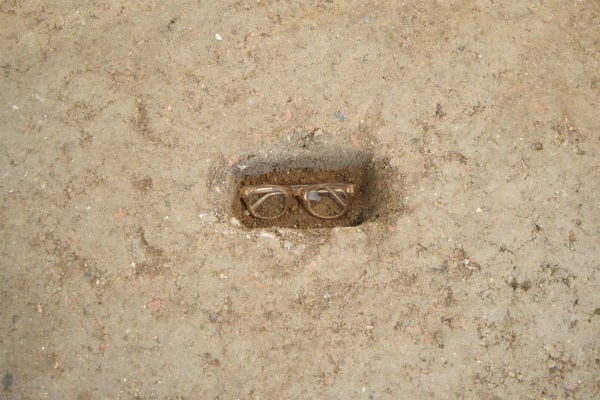
Detail of Subodh Gupta’s Pure (I)
Photo: Ben Davis
Here’s the context: Back in 1999, Gupta asked residents of villages around Delhi to give him objects that had particular significance for them, then buried them in a field treated with cow dung, a sacred substance in India. The people who gifted the objects are documented in black-and-white photographs accompanying this gallery remake, and Pure (I) shows more than any other work here why you can’t totally dismiss Gupta. He does have a mainline to raw material that feels important, even if it seems to remain raw material, literally only half uncovered.
Gupta is the son of a railwayman from Bihar, a very provincial part of India. He trained as a painter at the College of Arts and Crafts, Patna, and spent time as a set designer for a traveling theater company. Catching the wind of India’s rising status in the world in the go-go 2000s, he would be selling artwork for astronomical sums just a few short year later (as well as making Absolut ads). Recently, he and his wife, the artist Bharti Kher, sent the papers into a tizzy when they purchased a mansion in a chic neighborhood of Delhi for the equivalent of $18 million.
The market for his art has mainly not come from India, a fact that the Indian press can be snide about but that Gupta embraces: “We don’t have a lot of collectors in India… Thank god art lovers from abroad give us the possibility to express ourselves and to grow.” (Though it bears mentioning that he owes his earliest, pre-art-fair success to the patronage of Russi Mody, chairman of the vast conglomerate Tata Steel, whom he spent a year courting to play Saatchi to his Hirst.) The Guardian’s blessing-and-a-curse coronation of him, in 2007, as the “Damien Hirst of Delhi” is reductive, but there is a reason the title has stuck: Gupta makes art deliberately cut to fit international fashion.
Consider Imperial Metal (2014), a bundle of gold rebar displayed atop a charred wooden table. The trope of transforming everyday objects into precious simulacra, served up as some kind of vague, gold-plated commentary on “power, wealth, and urbanization” could be from an entry in the Big Book of Art-Fair Clichés.
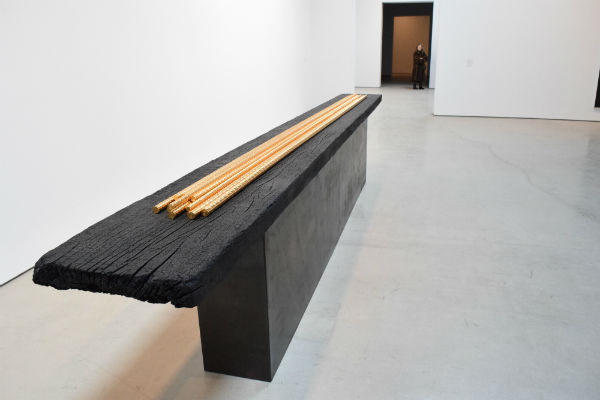
Subodh Gupta’s Imperial Metal (2014) at Hauser & Wirth
Photo: Ben Davis
Yet at the same time that the works feel very familiar in style, Gupta insists, “I’m just writing my diary, my story.” This kind of impulse to personal testimony is, in fact, the flip side of the conceptual familiarity; the global art circuit has produced a tremendous demand for testimony from newly “discovered” scenes in familiar styles; that’s the trick. “My work is about where I come from,” he told ArtNews. “But at the same time the expansion of the art world means that to a certain extent, everything is shrinking together, and you have to be aware of international discourses in your work.”
The consequences of this conjunction of forces are best seen in Gupta’s work My Family Portrait (2013). It is not much to look at, but a museum-style wall text explains that each of the three dish racks is literally from the home of one of Gupta’s three siblings. The sculpture displays the contents of their actual kitchens, from which we are meant to observe things about who they might be. It is as if the imperative to testify about “Indian identity” is so acute that the artist has resorted to presenting it in an anthropological way, instead of an artistic one.
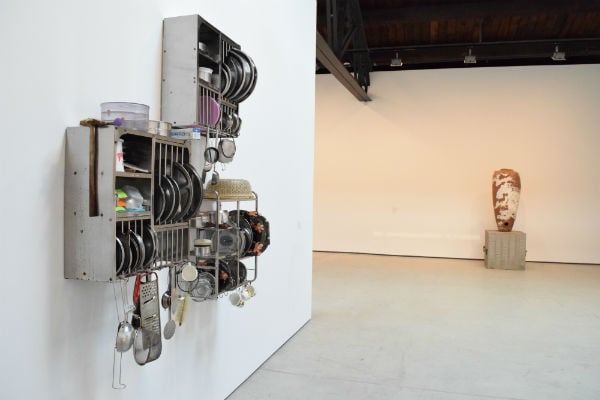
Subodh Gupta’s My Family Portrait (2013) (with In this vessel lie groves and gardens in the background) at Hauser & Wirth
Photo: Ben Davis
When you survey Subodh Gupta’s work overall, what you sense is a lot of unresolved parts: art tropes that feel fairly stock, but also personal narratives that feel largely unprocessed. This irresolution is the hallmark of an accelerated art world, of a machine that has been built so fast that the circuits connecting these two poles never really closed, allowing form and content to mutually transform one another into something truly notable and new.
Nevertheless, I wouldn’t totally give up on the guy. Gupta actually could be a lot more interesting than just fodder for curators looking for an “Indian Damien Hirst.” He has an interesting story to tell, about the hyped-up, global world we live in, where a boy from the boondocks in India can find himself suddenly with the entire world clamoring after his every brain dropping. It’s just that for now, as far as I can tell, his work still speaks mostly about the pitfalls of this state of affairs, which Gupta has to try to navigate with a white-hot spotlight illuminating all his missteps.
Subodh Gupta, “Seven Billion Light Years” is on view at Hauser & Wirth, 511 West 18th Street, New York, though April 25, 2015.